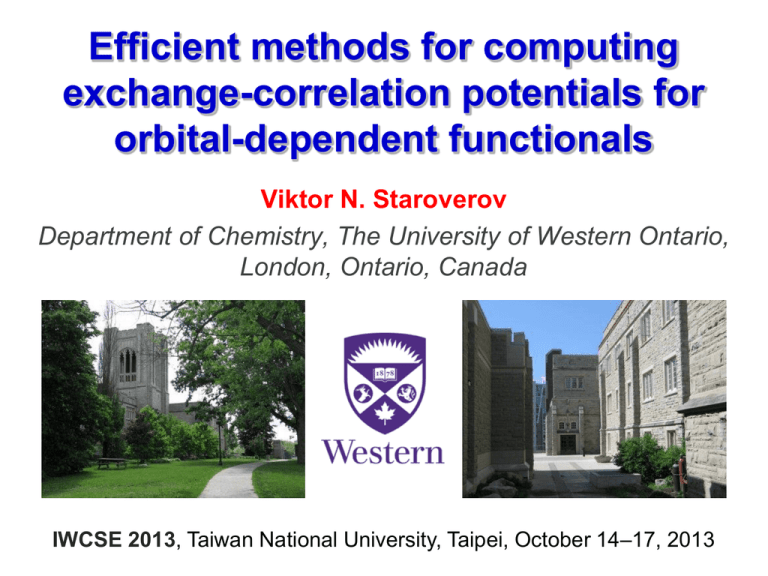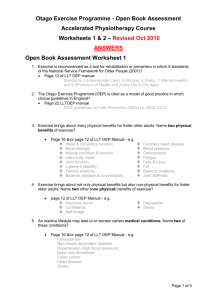PPT presentation
advertisement

Efficient methods for computing
exchange-correlation potentials for
orbital-dependent functionals
Viktor N. Staroverov
Department of Chemistry, The University of Western Ontario,
London, Ontario, Canada
IWCSE 2013, Taiwan National University, Taipei, October 14‒17, 2013
Orbital-dependent functionals
𝐸XC 𝜌 =
𝑓 𝜙𝑖
𝑑𝐫
Kohn-Sham orbitals
• More flexible than LDA and GGAs (can satisfy
more exact constraints)
• Needed for accurate description of molecular
properties
2
Examples
• Exact exchange
𝐸Xexact
1
𝜌 =−
4
𝑁
𝑑𝐫
𝑖,𝑗=1
∗
∗ ′
′
𝜑
𝐫
𝜑
𝐫
𝜑
𝐫
𝜑
𝐫
𝑖
𝑗
𝑗
𝑖
𝑑𝐫 ′
𝐫 − 𝐫′
same expression as in the Hartree‒Fock theory
• Hybrids (B3LYP, PBE0, etc.)
• Meta-GGAs (TPSS, M06, etc.)
3
The challenge
Kohn‒Sham potentials corresponding to orbitaldependent functionals
𝑣XC
𝛿𝐸XC [{𝜙𝑖 }]
𝐫 =
=?
𝛿𝜌(𝐫)
cannot be evaluated in closed form
4
Optimized effective potential (OEP)
method
Find 𝑣XC (𝐫) as the solution to the minimization
problem
𝛿𝐸total
=0
𝛿𝑣XC (𝐫)
OEP = functional derivative of the functional
5
Computing the OEP
Expand the Kohn‒Sham orbitals:
𝑛
𝜙𝑖 𝐫 =
𝑐𝑘𝑖 𝜒𝑘 (𝐫)
𝑘=1
orbital basis functions
Expand the OEP:
𝑚
𝑣XC 𝐫 =
𝑏𝑘 𝑓𝑘 (𝐫)
𝑘=1
auxiliary basis functions
Minimize the total energy with respect to {𝑐𝑘𝑖 } and {𝑏𝑘 }
6
Attempts to obtain OEP-X in finite basis sets
size
7
I. First approximation to the OEP:
An orbital-averaged potential (OAP)
Define operator 𝑢XC such that
𝛿𝐸XC [{𝜙𝑖 }]
𝑢XC 𝜙𝑖 𝐫 =
𝛿𝜙𝑖∗ (𝐫)
The OAP is a weighted average:
𝑣XC 𝐫 =
𝑁
∗
𝜙
𝑖=1 𝑖 𝐫 𝑢XC 𝜙𝑖
𝑁
∗
𝜙
𝑖=1 𝑖 (𝐫)𝜙𝑖 𝐫
𝐫
8
Example: Slater potential
Fock exchange operator:
𝛿𝐸Xexact
𝐾𝜙𝑖 𝐫 ≡
𝛿𝜙𝑖∗ (𝐫)
Slater potential:
1
𝑣S 𝐫 =
𝜌 𝐫
𝑁
𝜙𝑖∗ (𝐫)𝐾𝜙𝑖 (𝐫)
𝑖=1
9
Calculation of orbital-averaged
potentials
• by definition (hard, functional specific)
• by inverting the Kohn‒Sham equations
(easy, general)
10
Kohn‒Sham inversion
Kohn‒Sham equations:
1 2
− ∇ + 𝑣 + 𝑣H + 𝑣XC 𝜙𝑖 = 𝜖𝑖 𝜙𝑖
2
multiply by 𝜙𝑖∗ ,
sum over i,
divide by 𝜌
𝜏𝐿
1
+ 𝑣 + 𝑣H + 𝑣XC =
𝜌
𝜌
𝑁
𝜖𝑖 𝜙𝑖
2
𝑖=1
11
LDA-X potential via Kohn-Sham inversion
12
PBE-XC potential via Kohn‒Sham inversion
13
Removal of
oscillations
A. P. Gaiduk,
I. G. Ryabinkin, VNS,
JCTC 9, 3959 (2013)
14
Kohn‒Sham inversion for orbitalspecific potentials
Generalized Kohn‒Sham equations:
1 2
− ∇ + 𝑣 + 𝑣H + 𝑢XC 𝜙𝑖 = 𝜖𝑖 𝜙𝑖
2
same manipulations
𝜏𝐿
1
+ 𝑣 + 𝑣H + 𝑣XC =
𝜌
𝜌
𝑁
𝜖𝑖 𝜙𝑖
2
𝑖=1
15
Example: Slater potential through
Kohn‒Sham inversion
1 2
𝛻 𝜌 𝐫 − 𝜏(𝐫) +
𝑣S 𝐫 = 4
𝜌 𝐫
𝑁
𝑖=1 𝜖𝑖 |𝜙𝑖
(𝐫)|2
− 𝑣 𝐫 − 𝑣H (𝐫)
where
1
𝜏=
2
𝑁
|𝛻𝜙𝑖
𝑖=1
|2
1 2
= 𝜏𝐿 + 𝛻 𝜌
4
16
Slater potential via Kohn‒Sham inversion
17
OAPs constructed by Kohn‒Sham inversion
18
Correlation potentials via Kohn‒Sham inversion
19
Kohn‒Sham inversion for a fixed set
of Hartree‒Fock orbitals
Slater potential:
𝑣SHF =
−𝜏𝐿HF +
𝑁
HF HF |2
𝜖
𝑖=1 𝑖 |𝜙𝑖
𝜌HF
− 𝑣 − 𝑣HHF
𝑁
HF |2
𝜖
|𝜙
𝑖=1 𝑖 𝑖
𝜌HF
− 𝑣 − 𝑣HHF
But if 𝜙𝑖OEP ≈ 𝜙𝑖HF , then
𝑣XOEP ≈ 𝑣Xmodel =
−𝜏𝐿HF +
20
Dependence of KS inversion on orbital energies
21
II. Assumption that the OEP and HF
orbitals are the same
The assumption
𝜙𝑖 = 𝜙𝑖HF
leads to the eigenvalue-consistent orbitalaveraged potential (ECOAP)
𝑣XECOAP
=
𝑣SHF
1
+ HF
𝜌
𝑁
(𝜖𝑖 −
𝜖𝑖HF )
HF 2
𝜙𝑖
𝑖=1
22
ECOAP ≈ KLI ≈ LHF
23
Calculated exact-exchange (EXX) energies
𝐸EXX − 𝐸OEP , mEh
m.a.v.
KLI
ELP=LHF=CEDA
ECOAP
2.88
2.84
2.47
Sample: 12 atoms from He to Ba
Basis set: UGBS
A. A. Kananenka, S. V. Kohut, A. P. Gaiduk, I. G. Ryabinkin, VNS,
JCP 139, 074112 (2013)
24
III. Hartree‒Fock exchangecorrelation (HFXC) potential
An HFXC potential is the 𝑣XC (𝐫) which reproduces
a HF density within the Kohn‒Sham scheme:
1 2
− ∇ + 𝑣 𝐫 + 𝑣H 𝐫 + 𝑣XC 𝐫 𝜙𝑖 (𝐫) = 𝜖𝑖 𝜙𝑖 (𝐫)
2
That is, 𝑣XC (𝐫) is such that
𝑁
𝜌 𝐫 =
𝑁
𝜙𝑖 𝐫
𝑖=1
2
𝜙𝑖HF
=
𝐫
2
= 𝜌HF (𝐫)
𝑖=1
25
Inverting the Kohn–Sham equations
Kohn‒Sham equations:
1 2
− ∇ + 𝑣 + 𝑣H + 𝑣XC 𝜙𝑖 = 𝜖𝑖 𝜙𝑖
2
multiply by 𝜙𝑖∗ ,
sum over i,
divide by 𝜌
𝜏𝐿
1
+ 𝑣 + 𝑣H + 𝑣XC =
𝜌
𝜌
𝑁
𝜖𝑖 𝜙𝑖
2
𝑖=1
local ionization
potential
26
Inverting the Hartree–Fock equations
Hartree‒Fock equations:
1 2
− ∇ + 𝑣 + 𝑣H + 𝐾 𝜙𝑖HF = 𝜖𝑖HF 𝜙𝑖HF
2
same manipulations
𝜏𝐿HF
𝜌HF
+ 𝑣 + 𝑣H +
𝑣SHF
1
= HF
𝜌
𝑁
𝜖𝑖HF 𝜙𝑖HF
2
𝑖=1
Slater potential built
with HF orbitals
27
Closed-form expression for
the HFXC potential
HF
𝑣XC
1
HF
= 𝑣S +
𝜌
𝑁
𝑖=1
1
2
𝜖𝑖 |𝜙𝑖 | − HF
𝜌
𝑁
𝑖=1
HF HF 2
𝜖𝑖 𝜙𝑖
𝜏 HF 𝜏
+ HF −
𝜌
𝜌
Here
𝜌 = 𝜌HF , but 𝜙𝑖 ≠ 𝜙𝑖HF , 𝜖𝑖 ≠ 𝜖𝑖HF , and 𝜏 ≠ 𝜏 HF
We treat this expression as a model potential within the
Kohn‒Sham SCF scheme.
Computational cost: same as KLI and Becke‒Johnson (BJ)
28
HFXC potentials are practically exact OEPs!
Numerical OEP: Engel et al.
29
30
31
HFXC potentials can be easily computed
for molecules
Numerical OEP: Makmal et al.
32
Energies from exchange potentials
𝐸EXX − 𝐸OEP , mEh
m.a.v.
KLI
LHF
BJ
1.74
1.66
5.30
Basisset OEP
0.12
HFXC
0.05
Sample: 12 atoms from Li to Cd
Basis set for LHF, BJ, OEP (aux=orb), HFXC: UGBS
KLI and true OEP values are from Engel et al.
I. G. Ryabinkin, A. A. Kananenka, VNS, PRL 139, 013001 (2013)
33
Virial energy discrepancies
For exact OEPs,
𝐸vir − 𝐸EXX = 0,
where
𝐸vir = ∫ 𝑣X 𝐫 3𝜌 𝐫 + 𝐫 ⋅ ∇𝜌(𝐫) 𝑑𝐫
𝐸vir − 𝐸EXX , mEh
KLI
m.a.v. 438.0
LHF
BJ
629.2 1234.1
Basis-set
HFXC
OEP
1.76
2.76
34
HFXC potentials in finite basis sets
35
Hierarchy of approximations to
the EXX potential
𝑣X
1
HF
= 𝑣S + HF
𝜌
𝑁
𝜖𝑖 − 𝜖𝑖HF 𝜙𝑖HF
𝑖=1
HF − 𝜏
𝜏
2
+
𝜌HF
OAP
ECOAP
HFXC
36
Summary
• Orbital-averaged potentials (e.g., Slater) can be
constructed by Kohn‒Sham inversion
• Hierarchy or approximations to the OEP:
OAP (Slater) < ECOAP < HFXC
• ECOAP Slater potential KLI LHF
• HFXC potential OEP
• Same applies to all occupied-orbital functionals
37
Acknowledgments
• Eberhard Engel
• Leeor Kronik
for OEP
benchmarks
38










